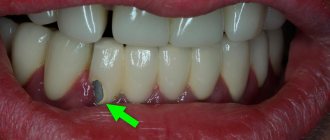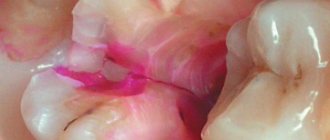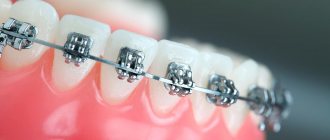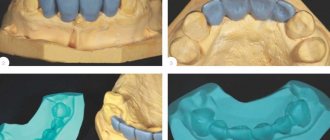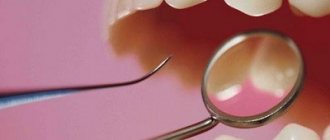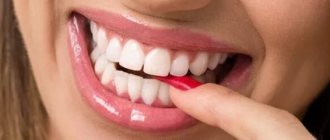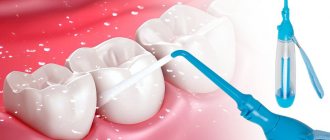From this article you will learn:
- what is aesthetic dental restoration,
- how it is carried out, patient reviews,
- price for restoration of front teeth in Moscow.
Artistic dental restoration is an aesthetic method of restoring damaged teeth, which gives them a natural appearance by simulating dental tissues with various materials. This method differs from conventional tooth filling in that in this case it is not just about restoring the shape and function of a damaged tooth, but when the doctor tries to achieve high aesthetics (so that the restored tooth cannot be distinguished from a healthy one). In dentistry, the terms aesthetic or cosmetic can also be used to refer to this type of restoration.
The artistic restoration method is more expensive compared to conventional traditional dental fillings, which has its justification. To achieve good aesthetics, it is important to restore not only the shape of the tooth, but also its color and transparency. Restoring the latter is the most difficult, because... Human teeth have different shades and transparency all the way from the cutting edge to the neck of the tooth. Therefore, making a tooth natural in color and transparency, as well as indistinguishable from neighboring teeth, requires not only skill and more expensive filling materials, but also a lot of time.
Dental restoration: photo (restoration of the 14th tooth, i.e. the first premolar of the upper jaw)
It should be clarified that the method of artistic restoration is used not only to restore teeth destroyed by caries, but also for congenital or acquired changes in the color of the enamel, age-related abrasion of teeth, chipping of the incisal edge, as well as for changing the unsightly shape of a tooth or moderate correction of its inclination. An alternative to the aesthetic restoration of teeth with filling materials can be other methods of cosmetic dentistry - ceramic and metal-ceramic crowns, as well as veneers.
Methods of aesthetic dental restoration –
Probably, as you already understood, this article will talk about “direct restorations,” i.e. when tooth restoration is carried out using filling materials. However, there are also so-called “indirect restorations” (see below).
- Direct dental restoration – also known as dental restoration using light-curing composite material (i.e., photopolymers), and is done by dental therapists. It is this type of restoration that we will examine in detail in our article. This method also includes restoration of teeth with composite veneers, more about which you can read in the article at this link.
- Indirect dental restoration - in the manufacture of this type of restoration, an orthopedic dentist (prosthetist) takes part, as well as a dental technician sitting in a dental laboratory.
This includes prosthetics with ceramic veneers, metal-ceramic ceramic crowns, restorative ceramic inlays. In this case, the tooth is first prepared and then an impression is taken of it. Based on this impression, an inlay, veneer or crown is made in a dental laboratory, and then fixed to the teeth using cements. For indirect restoration methods, mainly only ceramics are used - this can be Emax, zirconium dioxide, feldspathic ceramics. If we are talking about aesthetic restoration with metal-ceramic crowns, then for their metal frame they use not an ordinary cobalt-chromium alloy, but alloys of precious metals (for example, gold-palladium). Alloys containing gold give metal-ceramic crowns a more natural shade. Read more about indirect restoration methods in the articles:
→ Restoration with ceramic veneers → Restoration with metal-ceramics → Restoration with ceramic crowns
Main stages of indirect restoration
- Preparation. Before restoration, the oral cavity is sanitized. It allows you to eliminate all existing problems and prepare for the installation of artificial plates (veneers or lumineers). Preparation is usually carried out in 1-2 visits.
- Making veneers or lumineers based on impressions taken.
- Grinding of teeth (if veneers are installed). Lumineers are thinner. For this reason, turning is not required. A good “fit” of the plate can be achieved without changing the shape of the tooth.
- Recovery. Veneers or lumineers are fixed to the teeth using special cement. Its remains are eliminated. The doctor checks the bite.
Restoration of anterior teeth using composite filling materials –
In this chapter we will talk about how artistic restoration of the front teeth is carried out using specific examples - 1) in the first video you will see the replacement of an old, darkened restoration of a front tooth with a new one, 2) in the second video the restoration of an extensive chipped front tooth is shown. These videos perfectly demonstrate how artistic aesthetic dental restoration differs from conventional tooth filling.
For example, a special cast is used here to accurately restore the palatal surface of the tooth, as well as a layered restoration technique, which allows, by combining filling materials of different shades, to obtain an aesthetic result that is close to ideal (so that the restored part of the tooth does not differ in color and transparency from the natural tooth tissues). In fact, not all dentists have such skills, and there is no doubt that a certain artistic talent is needed.
Restoration of anterior teeth: video
The main stages of dental restoration:
- Preparation for restoration - at this stage it is necessary to hygienically clean the teeth from plaque and tartar, determine the color of the tooth being restored using a special scale and, in accordance with this, select the colors of the composite filling materials that will be used in the restoration process.
- Local anesthesia (if necessary)
- Drilling out tissues affected by caries - if an old unsatisfactory-looking restoration is being replaced, then the old filling is drilled out.
- Isolating a tooth from saliva - the use of cotton balls is almost universally a thing of history.
Their use does not allow reliably isolating the tooth from saliva, as well as from the patient’s wet breath, which also significantly worsens the quality and reliability of fillings and restorations made of composite filling materials. Now a rubber dam is used for this purpose. It is a latex scarf with holes for the teeth, which is pulled over the teeth. Composite dental restoration performed without reliable isolation from saliva and wet breath may not last long. Firstly, excessive moisture will cause a violation of the marginal seal of the filling to the tooth tissue, which can lead to the appearance of a dark strip or caries at the filling/tooth interface. Secondly, your restoration may simply fall out at one point, because... moisture impairs the adhesion of filling material to tooth tissue. - Fixing the pin in the canal - this stage is carried out if the crown of the tooth is destroyed by more than 1/2 and the tooth is pulpless. In this case, it is necessary to strengthen the filling by installing a pin, otherwise the restoration may fall out under load (24stoma.ru).
- Restoring the shape of a tooth with filling material – to make the tooth look natural, the layered restoration technique is used. In this case, layers of filling material of different shades and different transparency are applied to each other, which together then give the tooth a natural appearance. And this is real art.
- Finishing of the tooth – finishing should be understood as the final modeling of the tooth shape using burs, as well as grinding and polishing of the filling.
Indications for installation of veneers
Anyone can apply for the service of installing veneers, even in the absence of direct indications, only to improve the aesthetics of their smile. Dentists recommend resorting to this procedure in the following cases:
- presence of tooth damage: chips, cracks;
- progression of diseases leading to destruction of enamel;
- change in enamel color: the appearance of dark spots or yellowness;
- large gaps between teeth;
- increased sensitivity of teeth;
- distorted tooth shape.
Restoration of chewing teeth –
In videos 3 and 4 you can see how the restoration of chewing teeth is carried out with composite filling material. In video 3, the restoration can hardly be called “artistic”, because... The chewing surface of the tooth with all its fissures was restored only “satisfactorily”. However, this video does a good job of showing the restoration of the side walls of the tooth and the contact points between the teeth. Video 4 shows the final stage of a truly artistic restoration.
Contraindications for installation
Dentists do not recommend installing veneers in the following cases:
- absence of 5-7 chewing teeth;
- presence of large fillings;
- severe tooth damage;
- bruxism (involuntary grinding of teeth);
- severe malocclusion;
- soft enamel;
- diseases accompanied by destruction of tooth enamel or pulp.
Veneers should not be installed if there is a high risk of tooth injury (for example, if the patient is involved in extreme sports). Microprosthetics are also not performed on children and adolescents, because... their dentition has not yet fully formed.
Dental restoration: prices in clinics
For dental restoration, the price in different dental clinics will vary greatly, but truly high-quality aesthetic work in this case definitely cannot be cheap. To obtain a close to ideal aesthetic result, you need an experienced dentist with certain skills, training for which costs a lot of money, more expensive filling materials are also required, as well as a significant investment of time. All this increases the cost of the service.
When choosing a doctor, it is not enough to rely on reviews - ask to see before and after photos (of real patients treated in the clinic). It’s usually not worth relying on photographs on clinic websites, because... Most dental clinic websites do not post their own work, but pictures copied from the Internet. Below we will calculate the cost of dental restoration in a mid-price clinic (prices in premium segment clinics can be 2 or more times more expensive).
1) Complete restoration of the tooth crown –
In photos 7-9 you can see a real case of artistic restoration of the front teeth, performed with the crown part completely missing. When restoring tooth crowns, fiberglass pins and a composite light-curing filling material were used. For such dental restoration the cost will be no less than 6,000 rubles per tooth.
Restoration of anterior teeth: before and after photos
The cost of a complete tooth restoration consists of the following items.
- Anesthesia – from 400 rub.
- Applying a rubber dam to isolate a tooth from saliva – from 700 rubles.
- Sterile kit – from 150 rub. this includes: a mask and gloves for the doctor, shoe covers and a bib for the patient, the cost of sterilizing the instrument.
- Restoring a crown from a light composite costs about 3,500-5,000 rubles.
- Fixation of a WDW fiberglass pin in the channel – RUB 1,500.
this is a very important stage (Fig. 8)! The pin is necessary to prevent premature breakage of the restored tooth crown due to the fact that it will experience significant mechanical stress when chewing and biting off food. For the restoration of front teeth, it is very important that the pin is fiberglass and not metal - otherwise the metal will show through the filling material and the crown of the tooth will be bluish in color. Of course, you can install cheaper pins, for example: a) a metal pin (cost 50 rubles), but in this case, the restored tooth will not have the same transparency and natural shade “like natural teeth.” Although for teeth that are not included in the smile line, this is not so scary. b) Russian-made fiberglass pin (cost 50 rubles), but such pins also do not have proper light conductivity, and in addition have insufficient adhesion (stickiness) to filling materials. This leads to their poor fixation in the root canals and the risk of the “extended” tooth falling out along with such a pin. Total: the cost of tooth restoration is from 5,000 to 7,000 rubles.
2) Restoration of half a tooth –
If a full crown restoration (using a fiberglass pin) costs 5-7 thousand rubles, then restoring half a tooth crown without a fiberglass pin, but taking into account all other costs, will cost approximately 1500-2000 rubles less. Total: from 3500 to 4000 rubles.
3) Restoring a chipped cutting edge of a front tooth –
Restoring the angle of a tooth crown using a light-polymer filling material will cost from 1,500 to 3,000 rubles (depending on the amount of work/size of the chip).
Modern techniques
There are two methods of dental restoration: direct and indirect.
- Direct dental restoration is carried out using photopolymers or composite filling materials. The procedure is performed by a dentist-therapist.
- With indirect restoration, all tooth defects are eliminated using veneers (plates), which are glued with special cement to the front surface of the tooth. Before installing the veneer, the front surface of the tooth is ground and an impression is taken, from which the dental technician makes a ceramic structure.
Dental restoration: reviews
Very often, patients are dissatisfied with the way the restoration of the front tooth was performed (in terms of its shape, color and transparency).
Those. First of all, complaints are made specifically about insufficient aesthetics, and often the restored tooth simply looks like a real plastic crown, i.e. artificial and unnatural, standing out against the background of natural dental tissues. Examples of unsuccessful dental restorations: photos
Restoring aesthetics during restoration has 3 key points:
- Tooth shape - in fact, the work of restoring the anatomical shape of a tooth is very similar to the work of a sculptor who sculpts his model, but not from clay, but from filling material. Try to mold a tooth from simple plasticine with all its surfaces, cusps and fissures. I think that you will immediately understand that this requires a certain talent and artistic flair.
- Tooth color – it is necessary to achieve full matching of the shade of the restored tooth with the shades of neighboring teeth.
Filling materials have numerous shades (colors). For example, one factory package of Filtek filling material may contain 20 syringes of the material, each of which will have its own shade. The possibility of layer-by-layer application of a material with one shade onto a material with another shade (i.e., their combination) allows you to ultimately obtain all kinds of color combinations. Unfortunately, most dentists simply do not know how to use all the possibilities of modern filling materials and “play” with colors. The problem is further aggravated by the fact that the color of the tooth in the direction from the cutting edge to the neck of the tooth is always different, it changes, and this also needs to be taken into account. Otherwise, the restored tooth will be completely different from the patient’s neighboring “native” teeth. - Transparency of the tooth - in addition to the fact that the tooth changes its color in the direction from the cutting edge to the neck of the tooth, the transparency of the tooth also changes in exactly the same direction. Therefore, when restoring the cutting edge and cusps, those filling materials are used that, after exposure and curing, will have higher transparency.
Advantages and disadvantages of the method
The artistic method of restoration is characterized by undeniable advantages, including low invasiveness and the ability to restore a tooth without preparation or grinding. In addition, composite veneers are distinguished by high aesthetic performance.
Linings made by the direct method are inferior to ceramic structures in terms of service life, resistance to abrasion and dyes. However, affordable cost, relative simplicity, the ability to avoid deep grinding, as well as one-time production make this type of artistic dental restoration the most popular among patients.
Disadvantages of restorations –
- Restorations darken and lose their shine over time - fillings and restorations made from light-polymer filling materials tend to gradually darken. In addition, they lose the shine characteristic of healthy tooth enamel. If the loss of aesthetics on chewing teeth is not so terrible, then on the front teeth it is very unpleasant. Not very good restorations will have to be replaced every few years, but high-quality restorations should require periodic care (you need to visit the dentist once a year to polish them) - then their aesthetics will last longer.
- Risk of breakage of restorations - if your tooth is destroyed by more than 1/2, and especially if it is also depulped (nerve removed), and you still want to chew meat, then there is a risk of breakage of the restoration.
Depulped teeth are much more fragile than living ones. Particularly often, restored teeth break when the tooth is restored completely from the root. If the chewing load suddenly exceeds the strength limit of the restored structure, the restored part of the tooth breaks off. Sometimes this even causes a fracture of the tooth root (with the need for its subsequent complete removal). What is the best way to restore a tooth if it is destroyed by more than 1/2 - this is where indirect aesthetic restorations will help us, because ceramic crowns, veneers, etc.
Recovery and rehabilitation
The key to a long service life of veneers is proper care of the renewed teeth immediately after the procedure. In general, after installing the pads, you can lead a normal life, but you need to follow a few recommendations:
- During the first week, avoid eating too hot or cold foods.
- Do not crack nuts and seeds with your teeth - this can damage the veneer and it will have to be replaced.
- Avoid injury and falls.
- Maintain good oral hygiene.
A couple of weeks after installing the onlays, you need to visit the dentist for a follow-up examination. The doctor will check the correct location of the structure and the reaction of the oral mucosa to foreign objects. Please note: Dental grinding may cause sensitivity to hot or cold foods.
Alternatives to composite restorations –
An alternative to composite filling materials is ceramics, i.e. veneers, crowns, restorative inlays made from ceramics. The price corresponds to the quality, and therefore the cost of ceramic restorations will be significantly higher than composite dental fillings.
- Veneers – if your front tooth is destroyed mainly only on the front side, and the lingual part of the tooth is not very damaged, then in this case the best alternative to restoration would be a ceramic veneer. Precisely from ceramics, because ceramics do not darken at all and do not lose their shine over time. The only drawback of this type of prosthetics is its cost.
- Crowns (metal-ceramics or ceramics) - if your tooth is destroyed by more than 1/2 and especially if it is also depulped, we recommend abandoning restoration in favor of an artificial crown. By the way, restoring a tooth “from the root” costs the same as it costs to restore a tooth with a metal-ceramic crown.
- Inlays - if you need to restore a lateral chewing tooth, then an alternative to restoring a tooth from a composite filling material can be a restorative inlay. In terms of reliability, service life and aesthetics, ceramic inlays are at least 3-4 times superior to restorations. We hope that our article was useful to you!
Sources:
1. Personal experience as a dentist, 2. National Library of Medicine (USA), 3. Harvard Medical School (USA), 4. “Adhesive ceramic restorations” (Manier P.), 5. “Aesthetic dentistry and ceramic restorations ( Tuati B.).
Indications and contraindications
Restoring teeth with veneers allows you to make your smile more beautiful and snow-white. The procedure allows you to get rid of complexes associated with dental defects.
There are the following indications for installing overlays:
- the presence of large chips that cannot be corrected with a filling;
- diastema;
- minor curvatures;
- disproportionate shapes of teeth;
- the presence of defects on the enamel.
Before agreeing to dentition correction, you should pay attention to contraindications to it. Veneers are not installed if the bite is incorrectly formed. It is also necessary to refuse overlays in the following situations:
- pathological abrasion of the dentition;
- lack of chewing teeth;
- bruxism;
- the presence of mobile and pulpless teeth;
- severe tooth decay.
Fans of extreme sports are not recommended to do veneering. When diagnosing periodontal diseases, appropriate treatment is first carried out, and only then cosmetic correction is carried out.
Installation principle
Since installing veneers requires grinding down the teeth, thin enamel can be an obstacle to the procedure. The thickness of the protective shell of the tooth should be normal. This is necessary in order to ensure reliable fixation of the plates.
Reinforcing a broken tooth onto a pin
If the tooth root is healthy, the dentist can model an exact anatomical copy of its crown using computer technology. An x-ray is performed first.
The procedure is carried out as follows:
- A metal pin is installed into the sealed root canal;
- A filling compound is introduced, from which a new crown is formed.
Advantages of the method:
- Possibility to save the tooth root;
- High strength of the restored tooth due to double fasteners - the root and the pin.
Pins are used in cases where it is required:
- Building up the foundation;
- Strengthening a pulpless tooth;
- Reconstruction of a damaged tooth;
- Creating the basis for crown formation;
- Restoration.
The newest development is the use of fiberglass pins.
Crowns
A crown is a non-removable microprosthesis that preserves the tooth and protects the enamel from destruction by caries.
Crowns are made based on an impression. Pre-turning is performed. The resulting crown completely covers the tooth.
When to place a crown:
- If the tooth is significantly damaged by caries (over 70%);
- When the coronal part is destroyed due to injury;
- If the enamel has changed color;
- With increased tooth abrasion;
- To increase stability;
- When installing bridge structures.
What types of crowns are used:
- Metal ones - made of titanium, chromium, cobalt, gold or platinum - are rarely used;
- Metal-ceramic - the most popular - consist of a metal inner layer and a ceramic outer layer;
- All-ceramic - the most aesthetic and durable, made of zirconium dioxide;
- Porcelain - currently not used, since the method does not provide adequate structural strength.
Crown installation steps:
- Thorough diagnosis;
- Assessing the condition of the oral cavity, drawing up a treatment plan;
- Treatment of inflammatory processes, replacement of old fillings;
- If necessary, depulpation is performed;
- The tooth is prepared, the size of the removed layer depends on the selected crown material;
- Taking an impression with a special paste;
- Making a crown in the laboratory;
- Fitting;
- Fixation with temporary cement, the patient evaluates the degree of comfort;
- If there are no comments, replace temporary cement with permanent cement.
The service life of the crown is at least 10 years.
Price
Prices for aesthetic
dental restoration are based on several indicators:
- Status of the clinic and qualifications of specialists.
- Scope of dental crown restoration (full, partial, chipped restoration).
- Anesthesia depending on the drug.
- Rubber dam applications.
- Pin fixation, depending on the material and manufacturer.
- Consumables, including a sterile kit (gloves, mask, shoe covers, bib).
- Procedures for preparing a tooth for installation of a veneer (shaping the tooth, taking an impression, making a veneer).
| Service | Price, rub.) |
| Restoration of a chipped incisal edge of a tooth | from 1600 |
| Restoration of ½ tooth | from 3500 |
| Complete restoration of the crown with installation of a fiberglass pin | from 5000 |
| Complete restoration of the crown part of the tooth on a metal pin | from 4000 |
| Anesthesia | from 200 |
| Application of rubber dam | from 350 |
| Sterile kit | from 100 |
| Composite veneer | from 3000 |
| Ceramic veneer | from 12000 |
